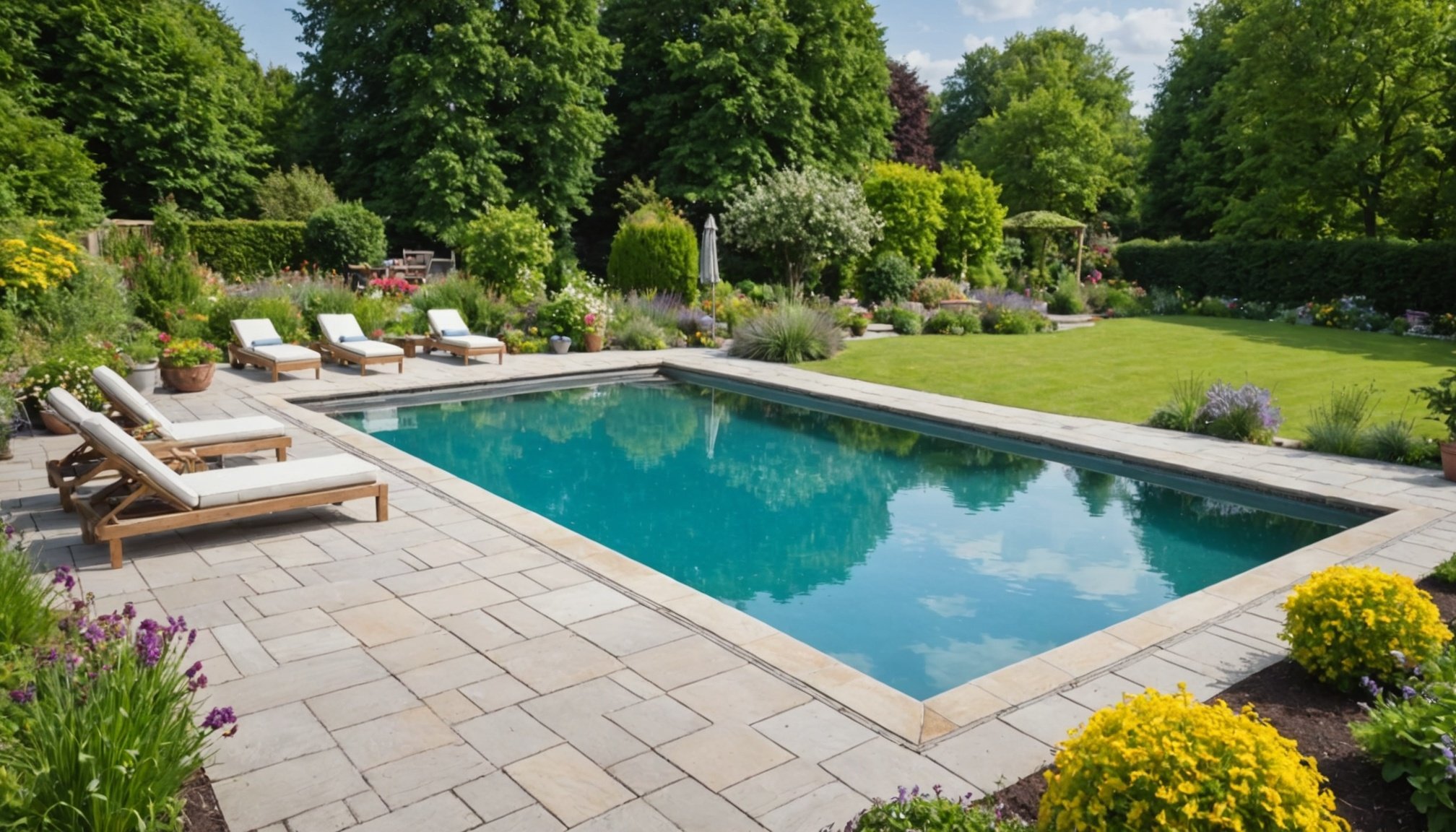Assessing Your Garden Space
A critical step in planning any pool installation is measuring garden space accurately. This ensures that you make the most efficient use of the available area and avoid any costly mistakes. Begin by gathering essential tools such as a measuring tape, a notepad, and a level. These will help you assess the space comprehensively.
When measuring, consider both the pool dimensions and any additional space needed for landscaping, poolside furniture, or walkways. An accurate measurement will allow you to plan for a fitting pool size without overwhelming the garden.
Lire également : Choosing the Perfect Skimmer for Managing Leaves in UK”s Lush Environments
It’s also crucial to identify potential obstacles or limitations. Be mindful of trees, underground utilities, or uneven terrain that can affect placement. Use visual markers or stakes to demarcate the pool area, providing a clear picture of how it will fit within the existing landscape.
Finally, measure and reassess the available area from different angles and lighting conditions. This can help reveal aspects that might be missed otherwise. Remember, the precision of your measurements can significantly influence the project’s success, ensuring that your pool enhances rather than encumbers your garden space.
Dans le meme genre : Essential Tips for Optimizing Your Pool Care Routine in the UK”s Summer Heat
Understanding Pool Types and Sizes
Choosing the right pool type and size for your garden can greatly enhance your outdoor space. Understanding the differences is crucial. There are primarily two pool types: inground and above ground. Inground pools, often seen as more permanent, can be custom-designed to fit any garden shape and provide a sleek aesthetic. They are ideal for those who plan to swim frequently or host large gatherings.
Above ground pools are generally more affordable and easier to install. They suit smaller gardens or those wanting a seasonal option without permanent changes to the landscape.
When considering pool size options, think about your garden layout. Small to medium garden layouts might benefit from a compact pool that doesn’t dominate the space, while large gardens can accommodate a more spacious design, allowing for versatile usage.
Lifestyle and usage also play a role in your decision. For instance, if you have young children, a less deep pool type might be safer. Additionally, those interested in water exercise might prioritise length for lap swimming over width. Consider these factors when selecting the pool that best suits your needs.
Design Considerations for Pool Integration
When planning a seamless pool integration, incorporating pool design into your existing garden is paramount. A harmonious blend between the pool and your garden aesthetics can elevate the entire outdoor experience. It begins with understanding the layout and key features of your garden. This way, you can ensure the pool complements its surroundings rather than imposing upon them.
Next, thoughtful landscaping and hardscaping around the pool area can significantly enhance its charm and functionality. Opt for plants and materials that not only align with your garden’s aesthetics but also thrive in proximity to water. This can help maintain visual continuity and harmony within your outdoor space.
Accessibility and safety are non-negotiable aspects of pool design. Consider pathways that are clear and slip-resistant, which make the pool easily reachable for everyone. Safe entry points, such as graded steps or handrails, are essential. Furthermore, ensure there are secure barriers or covers when the pool is unattended, ensuring a safe environment for families.
In essence, the interplay between garden aesthetics and landscaping around your pool shapes a cohesive and inviting atmosphere, while thoughtful design choices uphold safety and ease of access.
Regional Factors Influencing Pool Size
When considering pool installation in the UK, the climate plays a significant role in pool usage and maintenance. The UK’s temperate maritime climate typically limits optimal swimming conditions to the warmer months. This influences how often pools are used, the demand for heating solutions, and pool maintenance practices. Regular cleaning and temperature regulation become crucial to ensure the pool remains inviting and functional during cooler periods.
In addition to climatic considerations, planning permissions are essential for potential pool owners. To install a pool, one must adhere to local planning permissions, which can vary significantly depending on the region. This process ensures that the pool’s construction aligns with community development plans and existing infrastructure.
Moreover, regional regulations and zoning laws impact the pool’s dimensions and design. Authorities may restrict pool sizes in crowded urban areas to maintain spatial harmony and prevent overly-large constructions from dominating landscapes. Knowing the specific planning permissions and zoning laws affecting your area is vital. This knowledge assists homeowners in making informed decisions to avoid legal complications and ensure their pool meets all required criteria. Compliance ensures a smoother installation process and helps avoid costly mistakes.
Budgeting for Your Pool Installation
Installing a pool is an exciting venture, but it’s essential to prepare for the various pool installation costs. Understanding these expenses will help you create a structured financial plan.
Initially, the cost of pool installation can vary widely depending on your preferences, such as the pool’s size, shape, and material. Common expenses include permits, excavation, and operational equipment like pumps and filters. It’s crucial to get detailed estimates from contractors, ensuring all standard costs are covered.
Beyond installation, ongoing maintenance is vital. You should consider costs associated with cleaning, chemical treatments, and potential repairs. These future maintenance expenses can significantly impact your budget.
To manage finances efficiently, here are a few budgeting tips:
- Create a detailed list of potential costs and rank them by necessity.
- Research and compare multiple quotes from different contractors.
- Set aside funds for unexpected expenses that might arise during construction.
Additionally, explore financing options such as home equity loans or personal loans to make the project more manageable. By strategically planning your budget, you’ll ensure a smooth pool installation process while securing a financially sound future for your new aquatic retreat.
Maintenance and Care for Different Pool Sizes
When it comes to pool maintenance, understanding the differences in upkeep based on pool size is crucial. Smaller pools generally require less maintenance time, as they involve fewer chemicals and less cleaning. However, this doesn’t mean neglecting essential maintenance tasks.
Essential Maintenance Tasks and Frequency
For all pool sizes, regular cleaning is non-negotiable. Smaller pools might need a weekly skim and brush, while larger pools could demand more frequent attention. Ensuring balanced pool chemicals is crucial; test water weekly, regardless of size, adjusting pH and chlorine levels as necessary.
Common Issues Based on Pool Size
Larger pools often encounter issues with circulation and require more robust filtration systems. If these systems aren’t maintained, debris can linger, leading to algae growth. Smaller pools, on the other hand, face issues with chemical imbalances due to size, necessitating careful monitoring.
To handle these issues, invest in a reliable filtration system for larger pools and consider automatic chemical feeders for smaller ones to maintain balance effortlessly. Regularly inspect equipment and water conditions to ensure your pool stays pristine, whether large or small.
User Testimonials and Case Studies
User experiences provide a wealth of practical insights for anyone considering a pool installation in their UK garden. Real-life stories from individuals who successfully installed pools often highlight both the triumphs and challenges encountered throughout the process.
Many success stories involve overcoming common challenges such as space constraints and weather-related issues. For instance, users often note the importance of proper planning and employing professional guidance when navigating the notoriously unpredictable British climate. An individual recounted the strategic use of high-quality pool covers to maintain water temperatures and reduce maintenance complexity, ensuring year-round enjoyment.
Such accounts frequently mention creative solutions, like integrating the pool with existing landscaping, effectively utilising the limited space common to many UK gardens. This was a notable point in various user experiences, enhancing the practicality of pool installations where space is a premium.
Furthermore, inspiring visual showcases from these testimonials offer invaluable insights. Potential buyers are often motivated by seeing before-and-after images, depicting how pools can transform garden spaces while seamlessly blending into the natural environment. These success accounts not only inspire but also provide tangible examples of overcoming practical limitations, thereby making pool ownership an achievable aspiration for many.












